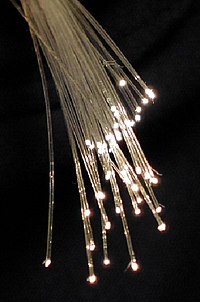
Photo from wikipedia
Recently developed fabrication methods for inorganic patterns (such as laser printing and optical lithography) can avoid some patterning processes conducted by conventional etching and lithography (such as substrate etching and… Click to show full abstract
Recently developed fabrication methods for inorganic patterns (such as laser printing and optical lithography) can avoid some patterning processes conducted by conventional etching and lithography (such as substrate etching and modulation) and are thereby useful for applications in which the substrates and materials must not be damaged during patterning. Simultaneously, it is also necessary to develop facile and economical methods producing inorganic patterns on various substrates without requiring a special apparatus while attaining the above-mentioned advantages. The present study proposes a reaction-based method for fabricating inorganic patterns by immersing substrates coated with a colloidal nanosheet into an aqueous solution containing inorganic precursors. Silica and TiO2 patterns spontaneously developed during the conversion of each inorganic precursor. These patterns were successful on rigid and flexible substrates. We fabricated these patterns on a wafer-sized silicon and large flexible poly(ethylene terephthalate) film, suggesting the scalability. We fabricated a biomimetic pattern on both sides of a glass window, as a photovoltaic roof, for minimal optical losses to maximally present photovoltaic effects of a solar cell. The TiO2 pattern on glass window exhibits sustainable sunlight-driven-cleaning activity for contaminants. The method could provide a platform for economical high-performance inorganic patterns for energy, environmental, electronics, and other areas.
Journal Title: ACS applied materials & interfaces
Year Published: 2022
Link to full text (if available)
Share on Social Media: Sign Up to like & get
recommendations!